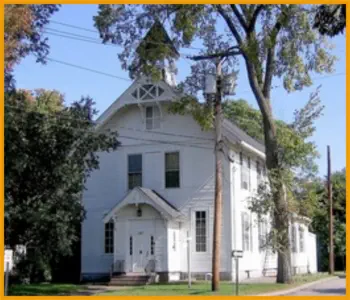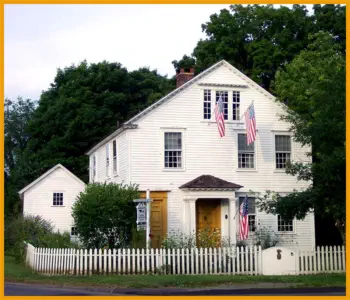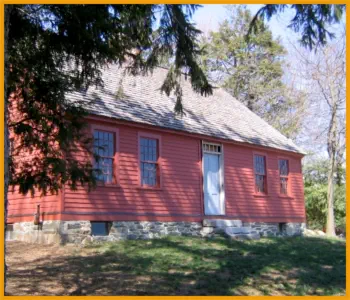



Orange Historical Society


Orange, Connecticut
History












Bryan Andrew


EXHIBIT REVIEW
“SNET Telephone Exhibit,” May 13th, 2022. Orange Historical Society, 605 Orange Center Road, Orange, CT, 06477.
The town of Orange is celebrating its bicentennial in 2022. In the digital age, it is easy to take for granted the availability of information via smart
phones, the internet, applications, and social media. The Orange Historical Society (OHS) recently compiled and opened a unique exhibit which
reminds viewers that the digital age owes much to the communication technology in the late-nineteenth century through the twentieth century.
Located at the OHS’s Academy Building in the town’s historic district, the exhibit features examples of communication technology ranging from
telegraphs and turn of the century candlestick to rotary dial phones and the equipment used by electric linemen.
The OHS is active in the community hosting numerous local events including hearth cooking classes and viewings of the historic district and his-
toric homes like the Stone Otis House on Orange Center Road. Like many historical societies in the state, the OHS takes tremendous pride in the
pres- ervation of public and local history. The pieces in this collection came from many donors including former linemen who parted with their old
toolbelts and climbing equipment to contribute to the exhibit. This exhibit commemo- rates the legacy of the Southern New England Telephone
(SNET) company. SNET was a major telecommunications company founded in 1878 and headquartered in New Haven. In a time before constant
connectivity, SNET employed up to 10,000 workers in the state at any given time through the twentieth century and provided telecommunications
services to the residents of New Haven County including the town of Orange. New Haven was even home to one of the first telephone exchanges in
the 1890s.
The exhibit includes nineteen original pieces including telephones used in both the homes of Connecticut residents and in various workplaces in the
state. The collection also contains vintage corded phones, nostalgic reminders of the phones on kitchen walls in suburban homes and city
apartments alike, in a variety of bright and unique colors. There are no replicas or reproduc- tions in this collection, all the pieces are originals and
well-preserved. Some of the older pieces in the collection include three telegraphs, the oldest of which was manufactured by Western Electric
Telegraph Key and Sound in 1892 and another that was used in Scobie’s Store on Orange Center Road at the turn of the twentieth century.
Organized in chronological order by year, the observer walks through nearly a century of telecommunications history, crossing the threshold from
candlestick and rotary style telephones to the wall phones manufactured by Western Electric intended for use on the railroads in the state. In
addition to Western Electric, the collection includes examples of telephones manufactured for home and office use through the twentieth cen- tury
by Bell, Leich, and Kellogg. At the center of the exhibit rests a Bell Sys- tem Desk Set from 1950 used by the Fire Department. The exhibit conveys
the memory of SNET as an important business in Connecticut by blending the phones with photographs that tell the stories of SNET employees in
the twentieth century.
Honoring the legacy of SNET in Connecticut also meant honoring the hardworking employees. Photographs of telephone operators and electric
linemen working in New Haven County, like chief operator Clara Cade in 1913 and operator Mary Pucillo in 1920, provide snapshots of a time
when connectivity was an emerging labor requiring complex service. The equip- ment used by the electric linemen including their toolbelts,
harnesses, and helmets indicate the tremendously difficult and strenuous work it took to keep Connecticut homes and businesses connected.
The exhibit was built by OHS leaders Ginny Reinhard, Michelle Stan- nard, and Barbara Carbone. OHS opened the exhibit on May 13, 2022, and is a
permanent, and growing, exhibit in the OHS’s collection. The telephones alone are examples of public history nostalgia and provide the observer
with a moment to reflect on how far communications have come. The unique wall phones from Leich, Western Electric, and Kellogg represent early
forms of communication for workers in the railroads, emphasizing the connection between telecommunications and industry in the twentieth
century. Lovers of public history and the memory of twentieth-century telecommunications alike will be transported to an era of communications
history that enabled the digital age we live in today.
NICHOLAS J. PISANO Southern Connecticut State University
From Connecticut History Review 61:2 (Fall 2022) Copyright 2023 by the Board of Trustees of the University of Illinois. Complimentary copy. Not
for distribution without permission.








Orange Historical Society
Orange, Connecticut








Bryan Andrew










EXHIBIT REVIEW
“SNET
Telephone
Exhibit,”
May
13th,
2022.
Orange
Historical
Society,
605
Orange
Center
Road,
Orange,
CT,
06477.
The
town
of
Orange
is
celebrating
its
bicentennial
in
2022.
In
the
digital
age,
it
is
easy
to
take
for
granted
the
availability
of
information
via
smart
phones,
the
internet,
applications,
and
social
media.
The
Orange
Historical
Society
(OHS)
recently
compiled
and
opened
a
unique
exhibit
which
reminds
viewers
that
the
digital
age
owes
much
to
the
communication
technology
in
the
late-
nineteenth
century
through
the
twentieth
century.
Located
at
the
OHS’s
Academy
Building
in
the
town’s
historic
district,
the
exhibit
features
examples
of
communication
technology
ranging
from
telegraphs
and
turn
of
the
century
candlestick
to
rotary
dial
phones
and
the
equipment
used
by electric linemen.
The
OHS
is
active
in
the
community
hosting
numerous
local
events
including
hearth
cooking
classes
and
viewings
of
the
historic
district
and
his-
toric
homes
like
the
Stone
Otis
House
on
Orange
Center
Road.
Like
many
historical
societies
in
the
state,
the
OHS
takes
tremendous
pride
in
the
pres-
ervation
of
public
and
local
history.
The
pieces
in
this
collection
came
from
many
donors
including
former
linemen
who
parted
with
their
old
toolbelts
and
climbing
equipment
to
contribute
to
the
exhibit.
This
exhibit
commemo-
rates
the
legacy
of
the
Southern
New
England
Telephone
(SNET)
company.
SNET
was
a
major
telecommunications
company
founded
in
1878
and
headquartered
in
New
Haven.
In
a
time
before
constant
connectivity,
SNET
employed
up
to
10,000
workers
in
the
state
at
any
given
time
through
the
twentieth
century
and
provided
telecommunications
services
to
the
residents
of
New
Haven
County
including
the
town
of
Orange.
New
Haven
was
even
home
to
one
of
the
first
telephone
exchanges in the 1890s.
The
exhibit
includes
nineteen
original
pieces
including
telephones
used
in
both
the
homes
of
Connecticut
residents
and
in
various
workplaces
in
the
state.
The
collection
also
contains
vintage
corded
phones,
nostalgic
reminders
of
the
phones
on
kitchen
walls
in
suburban
homes
and
city
apartments
alike,
in
a
variety
of
bright
and
unique
colors.
There
are
no
replicas
or
reproduc-
tions
in
this
collection,
all
the
pieces
are
originals
and
well-preserved.
Some
of
the
older
pieces
in
the
collection
include
three
telegraphs,
the
oldest
of
which
was
manufactured
by
Western
Electric
Telegraph
Key
and
Sound
in
1892
and
another
that
was
used
in
Scobie’s
Store
on
Orange
Center
Road
at
the
turn
of
the
twentieth
century.
Organized
in
chronological
order
by
year,
the
observer
walks
through
nearly
a
century
of
telecommunications
history,
crossing
the
threshold
from
candlestick
and
rotary
style
telephones
to
the
wall
phones
manufactured
by
Western
Electric
intended
for
use
on
the
railroads
in
the
state.
In
addition
to
Western
Electric,
the
collection
includes
examples
of
telephones
manufactured
for
home
and
office
use
through
the
twentieth
cen-
tury
by
Bell,
Leich,
and
Kellogg.
At
the
center
of
the
exhibit
rests
a
Bell
Sys-
tem
Desk
Set
from
1950
used
by
the
Fire
Department.
The
exhibit
conveys
the
memory
of
SNET
as
an
important
business
in
Connecticut
by
blending
the
phones
with
photographs
that
tell
the
stories
of
SNET
employees in the twentieth century.
Honoring
the
legacy
of
SNET
in
Connecticut
also
meant
honoring
the
hardworking
employees.
Photographs
of
telephone
operators
and
electric
linemen
working
in
New
Haven
County,
like
chief
operator
Clara
Cade
in
1913
and
operator
Mary
Pucillo
in
1920,
provide
snapshots
of
a
time
when
connectivity
was
an
emerging
labor
requiring
complex
service.
The
equip-
ment
used
by
the
electric
linemen
including
their
toolbelts,
harnesses,
and
helmets
indicate
the
tremendously
difficult
and
strenuous
work
it
took to keep Connecticut homes and businesses connected.
The
exhibit
was
built
by
OHS
leaders
Ginny
Reinhard,
Michelle
Stan-
nard,
and
Barbara
Carbone.
OHS
opened
the
exhibit
on
May
13,
2022,
and
is
a
permanent,
and
growing,
exhibit
in
the
OHS’s
collection.
The
telephones
alone
are
examples
of
public
history
nostalgia
and
provide
the
observer
with
a
moment
to
reflect
on
how
far
communications
have
come.
The
unique
wall
phones
from
Leich,
Western
Electric,
and
Kellogg
represent
early
forms
of
communication
for
workers
in
the
railroads,
emphasizing
the
connection
between
telecommunications
and
industry
in
the
twentieth
century.
Lovers
of
public
history
and
the
memory
of
twentieth-century
telecommunications
alike
will
be
transported
to
an
era
of
communications
history
that
enabled the digital age we live in today.
NICHOLAS
J.
PISANO
Southern
Connecticut
State
University
From
Connecticut
History
Review
61:2
(Fall
2022)
Copyright
2023
by
the
Board
of
Trustees
of
the
University
of
Illinois.
Complimentary
copy.
Not
for
distribution
without
permission.
































































































































